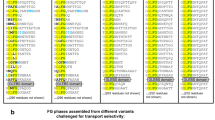Abstract
Human p53 was expressed in E. coli, purified, labeled with fluorescein iodoacetamide (IAF) and characterized for sequence-specific DNA binding and epitope disposition. Injected into the cytoplasm or nuclei of 3T3 cells IAF-p53 was imported into or exported from nuclei within minutes. Import was inhibited by coinjection of the lectin wheat germ agglutinine (WGA). In contrast, the peptide-protein conjugate NLS-HSA carrying the nuclear localization sequence (NLS) of the SV40 T antigen was only imported but not exported. 3T3 polykaryons were injected with IAF-p53 and photobleached by Scanning Microphotolysis in such a manner that only a single nucleus per polykaryon remained non-bleached. IAF-p53 was found to migrate rapidly (halftime ∼10 min) from non-bleached into bleached nuclei, while NLS-HSA did not. In digitonin permeabilized cells IAF-p53 was imported into nuclei. When removed from the medium after nuclear accumulation IAF-p53 was exported from the nuclei. Nuclear import and export of IAF-p53 both were rapid (halftimes of a few minutes, 22°C) and strongly inhibited by WGA or incubation on ice. NLS-HSA was only imported but not exported. We conclude that the nucleocytoplasmic transport of p53, in contrast to that of NLS-HSA, is bidirectional and that transport in both directions is carrier mediated and energy dependent. These results suggest that p53 contains nuclear export signals (NES) in addition to import signals (NLS) and thus open new views on the potential regulation of p53 cellular fractions.
This is a preview of subscription content, access via your institution
Access options
Subscribe to this journal
Receive 50 print issues and online access
$259.00 per year
only $5.18 per issue
Buy this article
- Purchase on Springer Link
- Instant access to full article PDF
Prices may be subject to local taxes which are calculated during checkout
Similar content being viewed by others
Author information
Authors and Affiliations
Additional information
An abstract describing some essential aspects of the work presented in this paper was published previously (Thülig et al., 1994)
Rights and permissions
About this article
Cite this article
Middeler, G., Zerf, K., Jenovai, S. et al. The tumor suppressor p53 is subject to both nuclear import and export, and both are fast, energy-dependent and lectin-inhibited. Oncogene 14, 1407–1417 (1997). https://doi.org/10.1038/sj.onc.1200949
Received:
Revised:
Accepted:
Issue Date:
DOI: https://doi.org/10.1038/sj.onc.1200949
Keywords
This article is cited by
-
Interaction of Pax6 with SPARC and p53 in Brain of Mice Indicates Smad3 Dependent Auto-regulation
Journal of Molecular Neuroscience (2010)
-
A high-content chemical screen identifies ellipticine as a modulator of p53 nuclear localization
Apoptosis (2008)
-
Genetic analysis of p53 nuclear importation
Oncogene (2007)
-
Nuclear export inhibitor leptomycin B induces the appearance of novel forms of human Mdm2 protein
British Journal of Cancer (2003)
-
An intact HDM2 RING-finger domain is required for nuclear exclusion of p53
Nature Cell Biology (2000)



